Figure 1.
Interaction between endocannabinoids, glutamate, and the HPA axis under stressful conditions. This figure summarizes the theory presented by Hill et al. (2010) about the intervention of eCBs, the glutamatergic (Glu) system, glucocorticoids (GC) and the corticotropin-releasing hormone (CRH) in response to different stressful stimuli, the stress response being dependent on glutamatergic neurons and CB1 signaling in murine models. The synapses illustrated occur in the amygdala, hypothalamus (HYP), hippocampus or prefrontal cortex (PC). Symbols show the nature of the effect on the HPA axis, either neutral (−), excitatory (+) or inhibitory (x). (A) The non-stressed condition enables to maintain normal levels of AEA and to stabilize Glu activity onto the basolateral amygdala (BLA) neurons, which does not affect the HPA axis. Under acute stressful situations (B), the HPA is activated to ensure the survival of the organism. In response to stress, fatty acid amide hydrolase (FAAH) activation promotes the hydrolysis of AEA in all brain regions considered, whereas there are unchanged or lower 2-AG levels in the amygdala and in the HYP, respectively. The impaired AEA/CB1 signaling onto Glu synapses in turn induces a higher Glu input onto BLA neurons. A negative fast feedback occurs when there is a hypersecretion of cortisol (C). Biosynthesis of eCBs is then engaged to activate CB1 receptors in Glu terminals, thus diminishing or even suppressing Glu release and further CRH production in a retrograde manner. BLA-GABAergic outflow through eCB signaling can also generate a negative fast feedback in the amygdala. During chronic stress (D), the insufficient increases of 2-AG/CB1 signaling induced by many stressful circumstances downregulates CB1 signaling in the medial PC and the HYP that results in a “hypocannabinoid state”.

